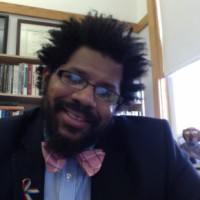Race on the ballot—again
In 1900, W.E.B. Du Bois named the color line as the problem of the 20th century. The color line, which still persists, is on trial this presidential election.
While Donald Trump polls low among black voters, these numbers have improved slightly. Black Trump supporters contend that President Obama’s tenure has done very little for their plight. Many cite what they see as Obama’s unwillingness to fully address the color line.
Yet black voters make up a largely Democratic bloc that resists political realignment—largely because of the way race, geography, and politics are intertwined. Republicans in the South have resisted legislation that empowers welfare recipients, LGBTQ folks, and people of color, particularly when forced into such reforms by the federal government. This perception of big government has fueled animosity on the part of white voters—and some of the racially charged disdain toward Obama in 2008 and 2012.
Political scientist V.O. Key famously analyzed shifts in the balance of power at notable historical points, such as the court ruling in Brown v. Board of Education. Key demonstrated how social and economic forces work together to realign parties across divisions of geography and race.
After Reconstruction, for example, Republicans dominated the national landscape. At the same time, anti-Lincoln and anti-Republican groups dominated politics in the Deep South. Southerners displayed a fervent hatred for Republicans and for the president who emancipated American Negroes. Born was the Solid South, a period from about 1877 to the second half of the 20th century during which southerners used racist tactics to uphold Jim Crow laws by electing only white Democrats. In this era, white supremacy maintained a state of racist terror characterized by the subjugation of black Southerners.
At the same time, white populists reached out to black voters. This was particularly true in Alabama, where segregationist governor George Wallace advanced the ideology of white supremacy under the guise of de facto segregation. Historian Dan Carter explains what happened next:
In 1974, as the number of black voters grew, Wallace prepared for his reelection by abandoning the racial rhetoric that marked his hard-fought 1970 campaign and quietly appealed for black political support around the state. In the wake of his successful reelection, Wallace acknowledged the support of black voters by appearing at the Dexter Avenue Baptist Church to welcome the Alabama Progressive Baptist State Convention to Montgomery. The audience warmly, even emotionally, greeted the wheelchair-bound Wallace. But in his remarks he made no apologies for his past actions and he defensively insisted that he had been a defender of states’ rights in the 1960s, not a racist.
Much like Trump in 2016, Wallace masked an unhidden belief in white superiority by telling black people he had their best interests at heart.
The Solid South persisted arguably until 1980, when a major shift transpired. Ronald Reagan swept the South (along with the rest of the nation) by promising to return to conservatism, reduce the size of the government, and restore social order after the turmoil of the 1960s and 1970s. Reagan’s promises were continuous with the law-and-order campaign propagated by Wallace and Richard Nixon, which Trump also aims to continue in 2016.
Southerners today are a product of political realignment. The South embraced Jim Crow policies until federal legislation and the Supreme Court deemed it illegal. Conservatives then sought candidates who would embrace the ideology of states’ rights in opposition to what they considered federal government overreach. Reagan’s endorsement of this position was clear in his objection to the Civil Rights Act of 1964 and the Voting Rights Act of 1965. He maintained that the federal government cannot legislate discrimination among civilians, a value also espoused by Trump.
Racism has long divided the working class. In 2016, many white working class Americans will vote for Trump, in large part because of race. While some salute a supposedly strong economy, in reality wages have flattened for the working class. White workers have grown suspicious of the burgeoning call for black power exemplified in the elevated voice of Black Lives Matter. With a suspect economy hurting white workers who feel attacked by traditionally marginalized people, this election year reveals the divided American color line. Once again, race is on the ballot.
Our weekly feature Then and Now harnesses the expertise of American religious historians who care about the cities of God and the cities of humans. It's published in partnership with the Kripke Center of Creighton University and edited by Edward Carson and Beth Shalom Hessel.





